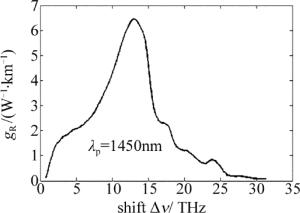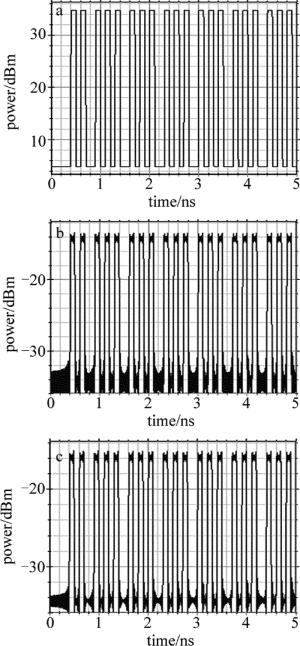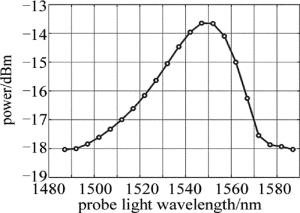HTML
-
全光波长转换器作为光通信中不可或缺的器件,相比较于光电波长转换具有高度透明性、高可靠性、兼容性以及响应速度快等优点[1],全光波长转换器能够高效、快速地将一种光波的信号通过非线性效应转移到另一波长的光波上去[2-3],克服了“电子瓶颈”的限制[4]。全光波长转换器对于光网络的可扩充性、稳定性、灵活性有较大的提升[5],将有限的波长运用多节点的需求,光网络的阻塞问题得到改善[6],提高了光网络的吞吐量[7],减少了交叉连接器的数目,对光网络的系统成本节省,以及传输容量提升有重要的意义。
全光波长转换的常用方法有交叉相位调制效应[8-9]、交叉增益调制[10]、交叉吸收调制、四波混频(four-wave mixing,FWM)[11]等方法。2010年,PELUSI根据FWM研究出30nm的波长转换器。2014年, ZHAO等人利用光子晶体光纤的交叉相位调制设计了抽运带宽为90nm的波长转换器[12]。2017年, OHTSUKI等人以交叉增益调制研究出5nm转换带宽,MARCONI基于四波混频研究出转换带宽5.5THz~12THz。受激喇曼散射效应(stimulated Raman scattering, SRS)作为波长转换的方法有以下的特点:转换系统简易;喇曼效应响应时间快(约0.1ps),可解决全光波长转换器响应速度慢的问题;其喇曼增益谱宽可实现较宽范围波长转换[13]。国内外目前只有作者的团队致力于喇曼效应的波长转换器的研究。2018年,作者团队基于碲基光纤中喇曼效应研究出转换带宽为73nm转换带宽,均采用线性拟合方法,所以未能充分利用增益谱。
光子晶体光纤(photonic crystal fiber, PCF)有3个优势:(1)微孔结构可以根据需求改变[14];(2)具有高非线性[15];(3)有宽达30THz的喇曼带宽。本文中以光纤中SRS的前向瞬态耦合波方程的解析解为理论模型,对光子晶体光纤的增益谱采取了高斯曲线拟合获得到了近100nm的转换带宽[16],给出实现的原理和方法,并用OptiSystem仿真实验证明了波长转换的可行性,得到可调谐的全光宽带波长转换器,并分析了探测光波长和光纤长度变化对波长转换器的几个参量影响。
-
根据光纤中N信道前向瞬态受激喇曼散射耦合波方程[17],得到可调谐全光波长转换器理论模型。利用光纤中受激喇曼散射的放大原理来实现波长转换技术[18],假设其中的一路波道所传输的信号为抽运信号光,另一路传输的是可调谐探测光,得到两波道解析解功率形式:
式中,Pi(t-z/u)为i波道t时刻、z处的输入探测光功率,u为光信号的群速度;Pi(z, t)为转换后的信号光功率;Pp(t-z/u)为i波道t时刻、z处的输入抽运光功率;gR为探测光与抽运光的喇曼增益系数;Gi, p为第i信道的探测光与抽运光的增益;νp为抽运光的频率;νavg为波道中的平均光频率;α为线性衰减系数;Ae为有效模场面积;M为保偏系数;z为光纤长度;Le为有效作用距离。
图 1为抽运光波长λp=1450nm时光子晶体光纤的喇曼增益谱[19],给出了喇曼系数gR随频移Δν的变化曲线。
为了获取较大波长转换范围,应尽可能地选取较大拟合频移范围,选取增益谱拟合范围为4THz~18THz。对增益曲线采用高斯拟合,得到高斯拟合函数如下式所示:
拟合之后与实际数值误差在5%之内,其中Δν为抽运光与探测光的频移差。
-
抽运光功率为Pp,第i信道探测光的功率为Pi,当Pp≫Pi, 可以近似认为所有探测光的平均频率与抽运光的频率近似相等,即νavg≈νp[20],从(2)式可得:
得到喇曼增益系数gR:
由(1)式可以得到:
将(7)式代入(6)式可得:
由于ITU-T的G.697中关于最低光接收机灵敏度的规定要求光接收机灵敏度为-18dBm,即可调谐波长转换范围选取的增益范围必须使转换后输出的探测光功率Pi(z, t)≥-18dBm,若输入抽运光功率为3W,光纤长度为0.5km,有效截面积为3μm2,代入(8)式可计算出临界喇曼增益系数gR, min=2.577W-1·km-1,保证转换输出功率不小于最低灵敏度-18dBm,进而由(4)式得到近似可调谐范围为[5.264, 17.829]THz,对应的频移范围为[175.291,593.706]cm-1,可以通过频移公式计算可调谐宽带波长转换范围[1487.82, 1586.58]nm:
式中,c为光速,λp为抽运光波长,λi为探测光波长。
1.1. 设计原理
1.2. 理论模型
-
基于光子晶体光纤可调谐宽带波长转换设计原理结构如图 2所示。
在OptiSystem的仿真中,忽略自发辐射噪声和散粒噪声。使用连续激光作为光源,光谱宽度为1MHz。输入信号比特序列设置为“0101001”。抽运光波长λp=1450nm,功率为3W。选择探测波长λi为1540nm和1565nm,其功率为-20dBm,PCF长度为0.5km,有效截面积为3μm2,色散系数为0.05ps/(nm·km),色散斜率为0.001ps/(nm2·km),光检测器的响应度为1A/W,暗电流为10nA[21]。
图 3a表示输入抽运信号波形,图 3b、图 3c表示波长1540nm和1565nm处的转换输出探测光波形。观察图 3a与图 3b、图 3c的波形图可知,转换后的探测光波形与抽运信号光的波形一致,证实了全光波长转换的可行性。
图 4为波长1540nm, 1565nm处眼图。眼图含有丰富的信息,从眼图中可以看到信号之间的串扰和噪声的影响,说明每个转换后的探测光具有高信噪比和码间干扰, 其眼睛线条清晰,并具有良好的张开度,眼图显示系统完全符合通信系统的要求。
-
光网络中,对全光波长转换器来说,转换波长范围的带宽对光网络传输容量有重要影响,前面提到ITU-T规定光接收机灵敏度最小为-18dBm,从转换后的光功率对可调谐范围研究,仿真中其它参量不变,波长转换范围为1487nm~1587nm,以5nm作为间隔对探测光波长改变,仿真结果如图 5所示。可以看到计算得到转换范围之内所转换后的光功率大于-18dBm,其理论可调谐波长范围通过仿真证实可行性。
-
在全光可调谐波长转换系统中,因为是基于光子晶体光纤的受激喇曼散射原理,所以系统中的非线性效应较强,而Q因子是信号与噪声的比值,为了进一步衡量转换后输出光信号质量,采用Q因子来衡量波长转换系统的输出信号的质量。由图 6可知, Q因子随着可调谐探测光波长向长波长转移时,Q因子曲线呈现先上升后下降的趋势,通过与喇曼增益谱进行对比发现其变化趋势一致,Q因子在1551nm附近取得最大值。综上可知, 在喇曼增益谱增益最大处转换得到的光信号其转换质量最优,误比特率最小。
-
根据(2)式和(3)式可知,影响波长转换质量因素有光纤长度、抽运光功率、以及喇曼增益系数,当确定抽运功率时,讨论了波长的影响,接下来研究光纤长度对波长转换效率的影响,逐步增加PCF的长度,取1551nm波长的转换效率为例,得到图 7。峰值转换效率的特点先增大然后减小,因为PCF长度从较小逐渐增长时,受激喇曼散射有效作用距离也在增加,喇曼增益增量大于传输衰耗,随着距离增加,当喇曼增益与衰耗相同时,转换效率达到最大,再次增加光纤长度,喇曼增益小于传输损耗,此时净增益减小,转换效率降低。
3.1. 波长转换器的可谐调性分析
3.2. 探测光波长变化对Q因子的影响分析
3.3. 光纤长度变化对转换效率的影响分析
-
设计了一种受激喇曼散射的可调谐全光宽带波长转换器,喇曼效应响应快在皮秒量级,解决响应速度慢的问题。对光子晶体光纤的喇曼增益谱采用高斯曲线拟合方法,仿真模拟证实基于受激喇曼散射前向瞬态耦合方程实现波长转换的可行性,采用曲线拟合相比于之前课题组采用的线性对碲基光纤拟合得到73nm和掺锗光子晶体光纤得到58nm波长调谐带宽取得了较为重要的突破,在满足接收机最小灵敏度下得到近100nm的可调谐波长范围。分析了Q因子随波长变化的特点,结果表明, 随波长的变化,Q因子的变化趋势与喇曼增益谱一致,在1551nm附近处转换质量最优,并分析了光纤长度变化对峰值转换效率的影响。这些研究为未来光网络的波长转换器波长分配以及光纤长度的配置具有参考性意义。

 Map
Map











 DownLoad:
DownLoad:





